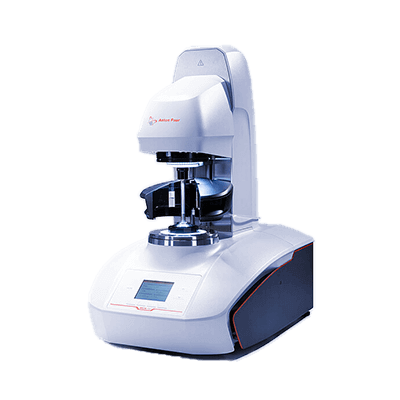What Is a Rheometer?

Rheology is the study of the flow and deformation of materials. Rheometry is a method for evaluating the rheological properties of materials, and a rheometer is the evaluation device used for this purpose.
By applying rotational or oscillatory motion to a sample set in the rheometer and measuring the stress generated, various properties can be quantified.
By changing the fixture in the sample setting section according to the type of sample, a variety of samples can be measured, from liquids to solids.
Uses of Rheometers
Here are some examples of rheometer applications:
- Quantification of texture, such as food texture and cosmetic feel.
- Evaluation of dispersion and sedimentation of paints and other materials, as well as assessment of coating properties.
- Evaluation of melting behavior and molding processability of polymers.
- Evaluation of the curing behavior of thermosetting adhesives and UV-curable resins.
- Evaluation of flowability in the manufacturing process.
- Study of temperature-dependent changes in physical properties.
Rheometers are utilized in a wide variety of fields. Viscosity and viscoelastic properties obtained from measurements serve as important indicators not only for research and development but also for quality control.
In fundamental research areas like polymer chemistry, rheometers are instrumental in exploring highly functional materials. They aid in developing safe and effective materials and products by examining molecular structures based on measurement results obtained using rheometers.
Principle of Rheometers
A rheometer is a device used to measure the viscosity and viscoelastic properties of materials.
Various sizes and shapes of fixtures are available in the sample setting section. Here, we introduce a fixture called a cone plate. The cone plate consists of a cone and a disc. The upper fixture is rotated or vibrated to measure the viscoelastic properties of the sample. In many cases, the temperature of the sample can also be controlled.
Viscosity is calculated from the rotational resistance (torque) when the upper fixture is rotated at a specific speed.
Viscoelastic properties can be obtained from the stress generated when the upper fixture is vibrated in a right-rotating, left-rotating, right-rotating manner. When the fixture is deformed by vibration in a sinusoidal manner, a sinusoidal stress, or stress wave, is obtained as a response from the sample. The phase difference between this stress wave and the sine wave used for deformation is used to determine the degree to which the sample is liquid or solid. The magnitude of the stress wave amplitude can be used to quantify the solidity of the sample.
The cone plate is designed to measure fluid samples that can be set between the upper and lower plates, while a clamp-type fixture can be used to measure solid samples formed into strips. Various types of fixtures are available, depending on the sample, allowing measurement of a wide range of samples, from solids to liquids. Additionally, properties such as relaxation modulus, creep compliance, yield stress, etc., can also be measured.
Rheometer Applications and Measurements
Rheometers offer a variety of options. In addition to evaluating viscosity and viscoelastic properties, you can:
- Control the sample environment, including humidity and UV irradiation.
- Combine Raman spectroscopy, small-angle light scattering, microscopy, and impedance measuring instruments to simultaneously measure viscosity and viscoelastic properties, enabling a comprehensive characterization.
- Apply the rheometer’s capabilities to measure powder flowability and surface friction resistance of powder flow and surfaces.
Notably, option (2) allows simultaneous measurement of impedance and Raman spectra alongside changes in physical properties associated with variations in sample temperature and deformation speed. This enables the acquisition of both macro physical properties such as viscosity and viscoelastic properties and internal information of the sample simultaneously.